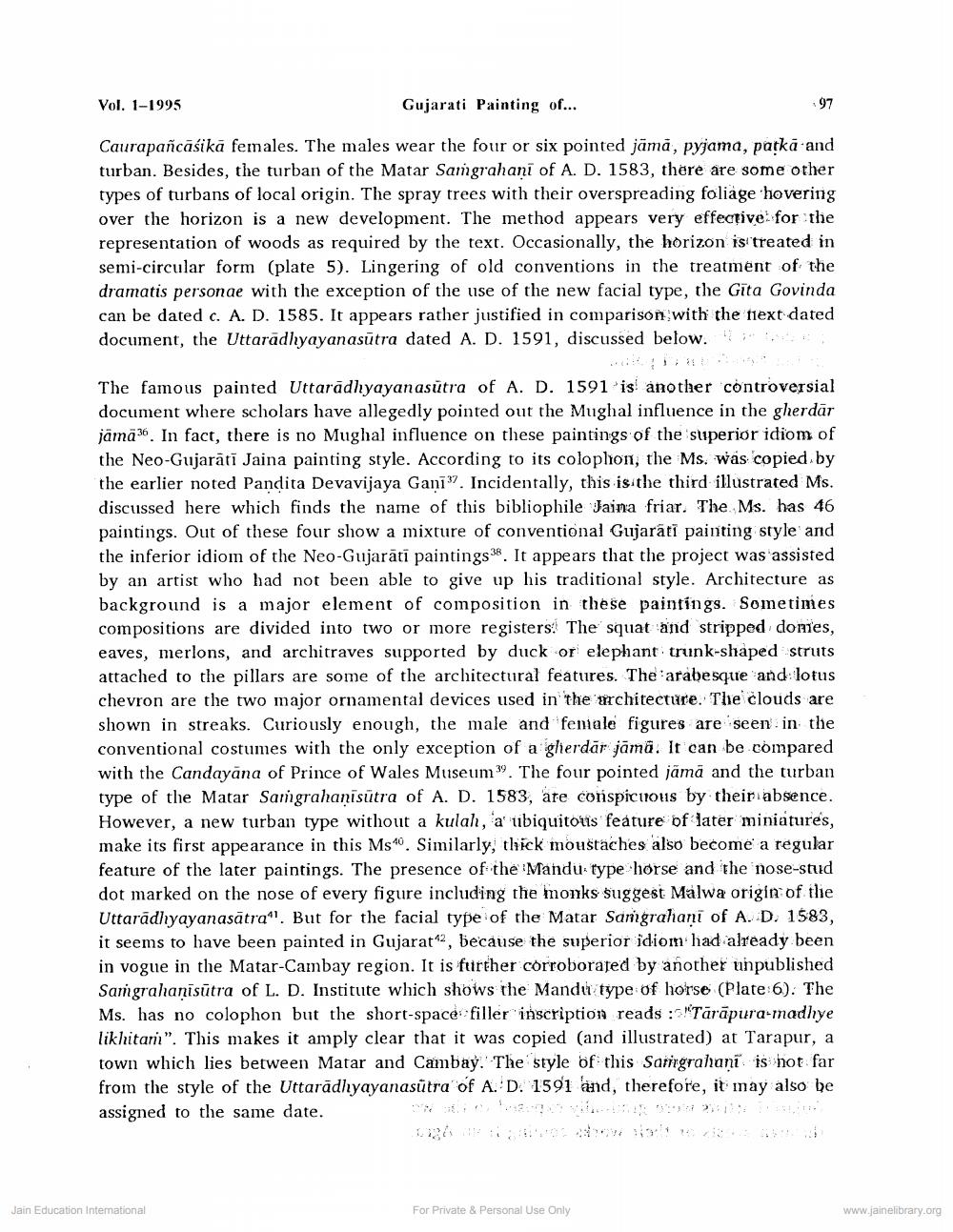________________
Vol. 1-1995
Gujarati Painting of...
Caurapañcāsika females. The males wear the four or six pointed jāmā, pyjama, patkā and turban. Besides, the turban of the Matar Samgrahani of A. D. 1583, there are some other types of turbans of local origin. The spray trees with their overspreading foliage hovering over the horizon is a new development. The method appears very effective for the representation of woods as required by the text. Occasionally, the horizon is treated in semi-circular form (plate 5). Lingering of old conventions in the treatment of the dramatis personae with the exception of the use of the new facial type, the Gita Govinda can be dated c. A. D. 1585. It appears rather justified in comparison with the next dated document, the Uttaradhyayanasūtra dated A. D. 1591, discussed below.
The famous painted Uttaradhyayanasutra of A. D. 1591 is another controversial document where scholars have allegedly pointed out the Mughal influence in the gherdār jamā36. In fact, there is no Mughal influence on these paintings of the superior idiom of the Neo-Gujarāti Jaina painting style. According to its coloplion, the Ms. was copied by the earlier noted Pandita Devavijaya Gani". Incidentally, this is the third illustrated Ms. discussed here which finds the name of this bibliophile Jaina friar. The Ms. has 46 paintings. Out of these four show a mixture of conventional Gujarati painting style and the inferior idiom of the Neo-Gujarāti paintings 38. It appears that the project was assisted by an artist who had not been able to give up his traditional style. Architecture as background is a major element of composition in these paintings. Sometimes compositions are divided into two or more registers: The squat and stripped domes, eaves, merlons, and architraves supported by duck or elephant trunk-shaped struts attached to the pillars are some of the architectural features. The arabesque and lotus chevron are the two major ornamental devices used in the wrchitecture. The clouds are shown in streaks. Curiously enough, the male and female figures are seen in the conventional costumes with the only exception of a ghierdār jāmā. It can be compared with the Candayāna of Prince of Wales Museum". The four pointed jämä and the turban type of the Matar Sangrahanisutra of A. D. 1583, are conspicuous by their absence. However, a new turban type without a kulah, a' ubiquitous feature of later miniatures, make its first appearance in this Ms. Similarly, thick moustaches also become a regular feature of the later paintings. The presence of the Mandu type horse and the nose-stud dot marked on the nose of every figure including the monks suggest Malwa origin of the Uttarādhyayanasātra". But for the facial type of the Matar Sangrahani of A. D. 1583, it seems to have been painted in Gujarat“, because the superior idiom had already been in vogue in the Matar-Cambay region. It is further corroborated by another unpublished Sangrahaņīsūtra of L. D. Institute which shows the Mandu type of horse (Plate 6). The Ms. has no colophon but the short-space -filler inscription reads :"Tārāpura-madhye likhitari". This makes it amply clear that it was copied (and illustrated) at Tarapur, a town which lies between Matar and Cambay. The style of this Sarrrgrahani is not far from the style of the Uttarādhyayanasūtra of A. D. 1591 and, therefore, it may also be assigned to the same date.
Jain Education Intemational
For Private & Personal Use Only
www.jainelibrary.org




